
FIS-BA-e-0512
35
9 Counting
operation
The
F
key is assigned to
and a reference number, e.g.
,
pre-selected.
Note: See chapters 6.2 – 6.4 for assignment of the function key
9.1 Important notes concerning piece counting
Counting of pieces with the aid of a balance is based on a weight comparison
between the items to be counted and the base weight of an item, the so-called
reference weight.
The determination of the reference weight is decisive with regard to piece
counting accuracy
. This is clearly shown by the following example.
Let us assume that one of the items to be counted weighs 1g.
This piece must be weighed in order to determine the piece weight. Let us also
assume that the weight of this piece is determined with an accuracy of 0.01g.
The relative accuracy, i. e. the relative error for this weight determination, is thus
0.01g divided by 1g, i. e. 1%.
If, for example, a large batch consisting of about a thousand pieces is to be
counted, this batch is weighed and the obtained weight value of this batch divided
by the reference weight, i. e. the weight of one piece.
The “n” number of pieces is thus derived from the division.
If the individual weight is determined within a margin of 1%, this error will be
transferred to the determination of the total number of pieces.
This means that when counting about 1000 pieces in this example, an error of
±
10 pieces is to be expected which, in turn, corresponds to 1% of 1000 pieces.
From this example it can be seen that the error (expressed in number of pieces)
during piece counting depends on the ratio of the number of pieces to be counted
to one piece (i.e. the reference piece).
In practice, a measuring error in the determination of the reference weight is
unavoidable. On the one hand, the accuracy of the balance is limited and on the
other, not all the pieces to be counted are of identical weight. They show a weight
tolerance which may easily fall within a percentage range.
If one happens to choose one of the lighter pieces as the reference piece, it is
obvious that the counting result will be different from the result which would be
obtained when choosing a reference piece with a weight in the upper section of
the dispersion range.
















































